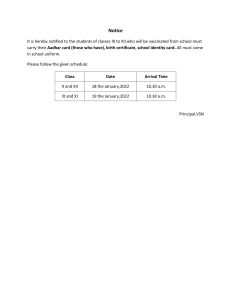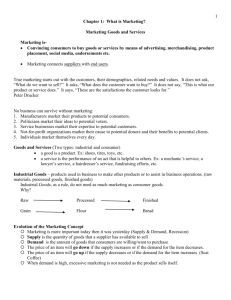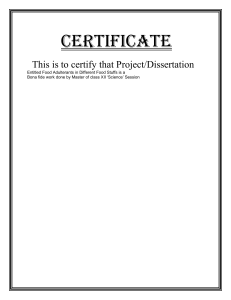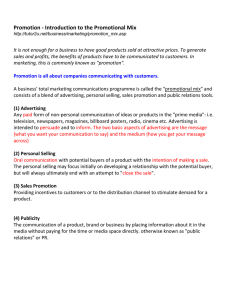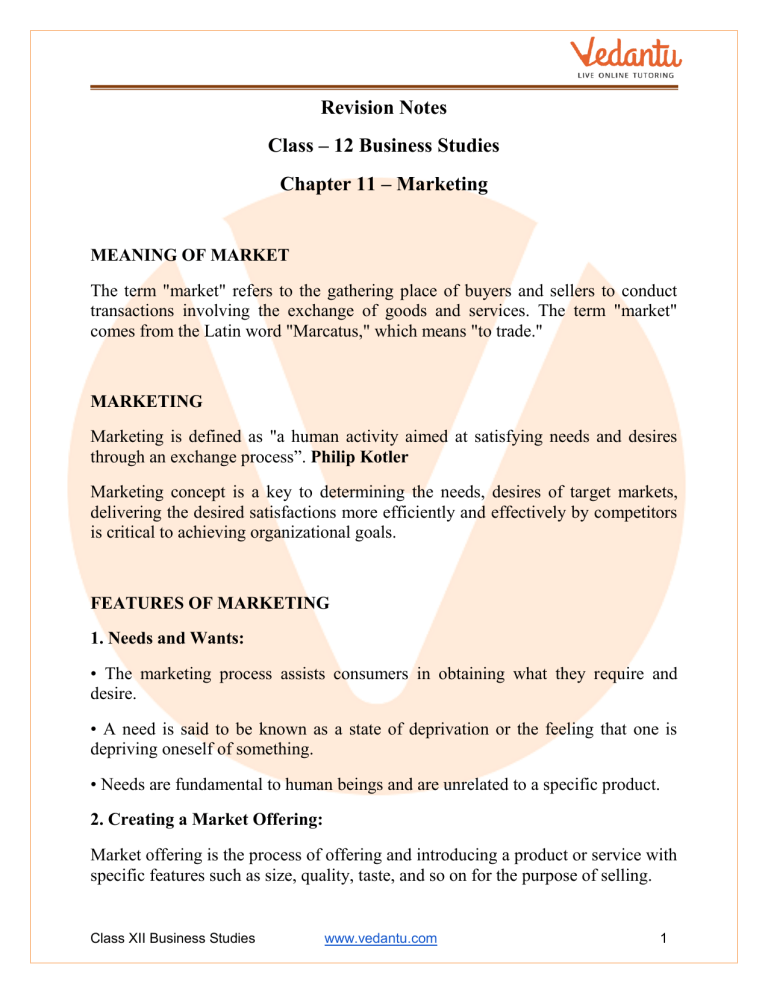
Revision Notes Class – 12 Business Studies Chapter 11 – Marketing MEANING OF MARKET The term "market" refers to the gathering place of buyers and sellers to conduct transactions involving the exchange of goods and services. The term "market" comes from the Latin word "Marcatus," which means "to trade." MARKETING Marketing is defined as "a human activity aimed at satisfying needs and desires through an exchange process”. Philip Kotler Marketing concept is a key to determining the needs, desires of target markets, delivering the desired satisfactions more efficiently and effectively by competitors is critical to achieving organizational goals. FEATURES OF MARKETING 1. Needs and Wants: • The marketing process assists consumers in obtaining what they require and desire. • A need is said to be known as a state of deprivation or the feeling that one is depriving oneself of something. • Needs are fundamental to human beings and are unrelated to a specific product. 2. Creating a Market Offering: Market offering is the process of offering and introducing a product or service with specific features such as size, quality, taste, and so on for the purpose of selling. Class XII Business Studies www.vedantu.com 1 3. Customer Value: Marketing used to facilitate the exchange of goods as well as services between buyers and sellers. 4. Exchange Mechanism: • The exchange mechanism is used in the marketing process. • Exchange refers to the process where two or more parties used to come together in order to get the desired goods or service from someone while in exchange for something. For example, money is the medium of exchange used to purchase or sell a product or service. • The following conditions needs to be met in order for an exchange to take place: a. There must be at least two parties. b. providing something of value to the other party c. communication d. freedom to accept or reject offer e. willingness of the parties to enter into a transaction What can be Marketed? 1. Physical product 2. Services 3. Ideas 4. Person 5. Palace 6. Experience 7. Properties 8. Events 9. Information Class XII Business Studies www.vedantu.com 2 10. Organisation Marketer • A marketer is anyone who makes an extra effort to identify the needs of the consumers and offer the product or service as well as persuade them in order to buy in the process of exchange. • Sellers, as marketers, are the ones who provide satisfaction. They make products/services available and sell them to customers in order to meet their needs and desires. • They are classified as follows: a. goods marketers (such as Hindustan Lever) b. services marketers (such as Indian Airlines) c. others marketing experiences or places (such as Walt Disney) (like tourist destinations). • Marketing activities are those undertaken by marketers in order to facilitate the exchange of goods and services between producers and consumers. MARKETING MANAGEMENT Marketing management is the administration of marketing functions. It is considered as the process of organizing, directing as well as controlling the activities associated with marketing goods and services in order to meet the needs of customers and achieve organizational goals. “Marketing management is defined as the art and science of selecting target markets and acquiring, retaining, and growing customers by creating, delivering, and communicating superior customer service.”Philip Kotler The process of management of marketing involves: a. Identifying a target market Class XII Business Studies www.vedantu.com 3 b. Creating demand by producing products that meet the needs and interests of customers. c. Create, develop, and communicate superior customer values: To provide superior value products/services to prospective customers, and to communicate these values to other potential buyers in order to persuade them to purchase the product/service. MARKETING AND SELLING Marketing: It refers to a broad range of activities, of which selling is only one component. Before making a sale, a marketer must plan the type, design, and price of the product, as well as select the distribution channels and the appropriate promotional mix for the target market. Selling: refers to the sale of a product or service through advertising, promotion, and salesmanship. The product's title is transferred from seller to buyer. The primary goal of selling is to turn a product into cash. Difference between marketing and selling Basis Marketing Selling Scope It is a broad term that encompasses a variety of activities such as identifying customer needs, product development, pricing, distribution, promotion, and selling. It is only a part of the marketing process. Focus Satisfying the needs and desires of the customers to the greatest extent possible. Title transfer from seller to consumer Aim Profits are generated as a result of customer satisfaction. Profits are generated by increasing sales volume. Emphasis Customer bending based on the product Creation of products that can meet the Class XII Business Studies www.vedantu.com 4 needs of the customers. Start and end activities It begins before a product is manufactured. It begins after a product is created. Strategies Product, promotion pricing, and physical distribution are all part of the effort. Efforts such as promotion and persuasion are required. MARKETING MANAGEMENT PHILOSOPHIES Marketing concepts/philosophies usually refers to determining the needs as well as wants of the target markets & then delivering the desired satisfactions more efficiently and effectively by competitors is critical to achieving organizational goals. 1. Production concept: Because the number of producers was limited in the early days of the industrial revolution, industrialists assumed that consumers were only interested in easily and widely available goods at an affordable price. 2. Product concept: • As time passed, supply improved, and customers began to prefer products that were superior in performance, quality, and features. • As a result, product improvement has become the key to a company's profit maximization. 3. Selling concept: • Increased production scale resulted in increased competition among sellers. Because there were so many companies selling similar products, product quality and availability were insufficient to ensure survival. Class XII Business Studies www.vedantu.com 5 • Consumers will not buy products unless the company engages in aggressive sales and promotional activities. 4. Marketing concept : • Marketing begins with determining what consumers want in order to satisfy consumers and profit. • Customer satisfaction is a prerequisite for achieving the firm's goals and objectives. 5. Social marketing concept: • Customer satisfaction is supplemented by social welfare in this concept. • A company that adopts the societal concept must balance the company's profits, consumer satisfaction, and societal interests. FUNCTIONS OF MARKETING 1. Gathering and Analyzing Market Information: • Systematic fact-gathering and information-analysis • Examining a business environment's strengths, weaknesses, opportunities, and threats. • Identifying customer needs and desires, determining purchasing motivations, selecting a brand name, packaging, and promotional media, and so on. • Data is available from both primary and secondary sources. 2. Marketing planning : • Create an appropriate marketing plan in order to meet marketing objectives. • It should specify the action plans to achieve these goals. • For example, if a marketer wants to increase his country's market share in the next three years, his marketing plan should include various important aspects such as a plan for increasing production levels, product promotion, and so on. Class XII Business Studies www.vedantu.com 6 3. Product designing and development: • Involves decisions about the product to be manufactured and its attributes, such as quality considerations, packaging, new models and variations, and so on. • A good design can improve the performance of the product while also giving it a competitive advantage in the market. • Anticipate customer needs and create new products or improve existing ones to meet those needs. 4. Standardization and grading: • Standardisation refers to the production of goods that meet predetermined specifications, which aids in the production of uniformity and consistency (e.g., ISI Mark). • Grading is said to be the process of categorizing different products into different groups based on important characteristics such as quality, size, and so on. 5. Packaging and labeling: • Packaging is called as the process of designing as well as developing a package for a product that protects it from damage, spoilage, breakage, and leakage. It also makes purchasing easier for customers and serves as a marketing tool. • Labeling is the process of designing a label to be placed on a package. It can range from a simple tag to intricate graphics. For example, colgate, lays, and so on. 6. Branding: • It aids in product differentiation, builds customer loyalty, and promotes sales. • An important decision area is branding strategy, which determines whether each product will have a separate brand name or the same brand name will be used for all products. 7. Customer Support Services: • Customer support services are extremely effective at increasing prospective customer sales and developing brand loyalty for a product. Class XII Business Studies www.vedantu.com 7 • It aims to provide maximum customer satisfaction while also building brand loyalty. • Examples include sales services, customer complaints and adjustments, credit services, maintenance services, technical services, and consumer information. 8. Pricing of Product: • Product price refers to the amount of money that customers must pay in order to obtain a product. • It is an important factor in a product's success or failure. • Because the price of a product/service is related to its demand, the price should be set after considering all of the factors that influence the price of the product. 9. Promotion: • Product and service promotion entails informing customers about the firm's product, its features, and so on, and persuading them to purchase the products. • Promotional methods include advertising, personal selling, public relations, and sales promotion. 10. Physical Distribution: • The two major decision areas under this function are (a) the channels of distribution or marketing intermediaries to be used (e.g. wholesalers, retailers); and the marketing intermediaries to be used. (b) Physical movement of the product from the point of manufacture to the point of consumption. 11. Transportation: • Transportation refers to the physical movement of goods from one location to another. • When selecting a mode of transportation, various factors such as the nature of the product, cost, location of the target market, and so on should be considered. 12. Storage or Warehousing: Class XII Business Studies www.vedantu.com 8 • Proper storage of products is required to maintain a smooth flow of products in the market. • Storage and warehousing are used to protect against unavoidable delays in delivery or to meet contingencies in demand. MARKETING MIX • A large number of factors influence marketing decisions; these are classified as ‘non-controllable factors' and ‘controllable factors.' • Controllable factors are those that can be influenced at the firm level. • Environmental variables are factors that influence a decision but are not controllable at the firm level. • In order to be successful, a company must make sound decisions after analyzing controllable factors and keeping environmental factors in mind. • Marketing Mix refers to the set of marketing tools that a company employs to achieve its marketing objectives in the target market. • The success of a market offer is determined by how well these ingredients are combined to provide superior value to customers while also meeting sales and profit goals. ELEMENTS OF MARKETING MIX The marketing mix consists of four main elements A. Product B. Price C. Place/Physical Distribution D. Promotion These elements are used to popularly known as 4 P’s of the marketing. Class XII Business Studies www.vedantu.com 9 1. Product: A product is defined as "anything of value" that is offered for sale in the market. Colgate, Dove, and so on. 2. Price: the sum of money that a customer must pay in order to obtain a product or service. 3. Place: Physical product distribution, i.e. making the product available to customers at the point of sale. 4. Promotion: Informing customers about the products and convincing them to purchase them. PRODUCT A product, in the eyes of the customer, is a collection of utilities that is purchased because of its ability to meet a specific need. CLASSIFICATION OF PRODUCTS Products can be classified into two categories: Class XII Business Studies www.vedantu.com 10 (i) Consumers ‘products, (ii) Industrial products. A. Shopping Efforts Involved On the basis of the buyers' time and effort. 1. Convenience Products: Convenience goods are consumer products that are frequently purchased for immediate use. Medicines, newspapers, stationery, toothpaste, and so on. 2. Shopping Products: Shopping products are those in which buyers spend a significant amount of time comparing the quality, price, style, suitability, and so on at various stores before making a final purchase. For example, electronic goods, automobiles, and so on. 3. Specialty Products: Specialty products are goods that have unique characteristics that compel customers to go out of their way to purchase them. For example, art, antiques, and so on. B. Durability of Products 1. Non-durable Products: These are consumer goods that are consumed in a short period of time. For example, milk, soap, stationery, and so on. 2. Durable Products: Tangible items that can withstand repeated use, such as a refrigerator, radio, bicycle, and so on. 3. Services: Intangible services are those activities, benefits, or satisfactions that are sold, such as dry cleaning, watch repairs, hair cutting, postal services, doctor services, and so on. INDUSTRIAL PRODUCTS Industrial products are those that are used as inputs in the manufacturing process. Class XII Business Studies www.vedantu.com 11 Characteristics •Number of Buyers • Channel Levels • Geographic Concentration • Derived Demand • Role of Technical Considerations • Reciprocal Buying • Leasing Out Classification • Materials and Parts: items that are completely incorporated into the manufacturer's products. • Capital Items: the manufacture of finished goods, such as installations and equipment. Class XII Business Studies www.vedantu.com 12 • Supplies and Business Services: short-term goods and services that aid in the development or management of the final product. Repairs and maintenance, for example. BRANDING: Branding is the process of creating a corporate brand identity for consumers and imprinting that brand identity on their minds, which necessitates brand positioning and brand management. Amazon's Jeff Bezos The process of developing a product's distinct identity. It is the process of identifying a product by using a name, term, symbol, or design alone or in some combination. Brand: A name, term, sign, design, or some combination of the above used to identify and differentiate the seller's products from those of competitors. Advantages to the Marketers •Enables Product Differentiation Through Marking: It aids in distinguishing its product from that of its competitors. •Aids in the development of advertising and display programs •Differential Pricing: It allows a company to charge different prices for different products. •Ease of New Product Introduction Advantages to the Customers •Aids in Product Identification: Assists customers in identifying products. •Ensures Quality: Ensures product quality •Status Symbol: Brands become status symbols due to their quality As an example, consider Benz automobiles. Characteristics of Good Brand Name •Short, simple to say, spell, recognize, and remember Class XII Business Studies www.vedantu.com 13 •Suggest the product's advantages and characteristics. •Different from other products •Adaptable to packing or labeling requirements, as well as different advertising media and languages. • Versatile enough to accommodate new products; • Legally registered and protected PACKAGING Packaging: The act of designing and developing a product's container or wrapper. Because good packaging often aids in the sale of a product, it is referred to as a silent salesman. Levels of Packaging 1. Primary Package: This is the product's immediate container/covering, such as toffee in a wrapper, a match box, a soap wrapper, and so on. 2. Secondary Package: It's all about additional layers of protection that are kept until the product is ready for use, such as a red cardboard box for Colgate toothpaste. 3. Transportation Package: refers to additional packaging components required for storage, identification, and transportation, such as putting a package of toffees into cardboard boxes for storage at a manufacturer's warehouse and transportation. Functions of Packaging • Product Identification: Packaging aids in product identification. • Product Protection: The primary function of the packaging is to protect the product. • Facilitating Product Usage: It makes transportation, stocking, and consumption easier. • Product Promotion: Packaging makes sales promotion easier. Class XII Business Studies www.vedantu.com 14 • Rising Health and Sanitation Standards: It is believed that there is minimal adulteration in packaged goods. • Self-Service Outlets: Good and appealing packaging can help to promote a product. • Opportunities for Innovation: Packaging innovation has increased the shelf life of products. For example, tetra packs for milk. • Product differentiation: The color, size, material, and other characteristics of packaging influence customers' perceptions of the product's quality. LABELLING Labeling is the process of affixing identification marks to a package. Labels are information carriers that provide information such as the name of the product, the name of the manufacturer, the contents of the product, the expiry and manufacturing date, general information for use, weight, and so on. Labels perform following functions: 1. Identify the product: It assists customers in identifying the product among the various types of products available. For example, the purple color of a Cadbury chocolate label easily distinguishes it from other chocolates. 2. Describe and specify the product's contents: The manufacturer provides all information regarding the product's contents, etc. 3. Product grading: With the help of labels, products can be classified into different categories based on quality, nature, and so on, for example: Brooke Bond Red Label, Brooke Bond Yellow Label, Brooke Bond Green Label, and so on. 4. Aids in product promotion: Attractive and colorful labels excite customers and entice them to purchase the products. For example, 40 percent extra free, as stated on detergent, buy two get one free, and so on. 5. Providing legal information: There is a legal requirement to print the batch number, maximum retail price, weight/volume on all products, and a statutory warning on the packet of cigarettes, “Smoking is harmful to one's health”: In the Class XII Business Studies www.vedantu.com 15 event of a hazard on/poisonous material, appropriate safety warnings should be posted. II. PRICING Meaning of Price: It is considered as the sum of the values that customers exchange in exchange for the benefit of owning or using the product. Price can thus be defined as the sum of money paid by a buyer (or received by a seller) in exchange for the purchase of a product or service. FACTORS DETERMINING PRICE DETERMINATION: 1. Pricing Objectives • The marketing firm's goal is to maximize profits. Pricing objectives can be determined in both the short and long run. If the company wants to maximize profits in the short run, it will charge the highest price for its products. However, in order to maximize its total profit in the long run, it would choose a lower per unit price in order to capture a larger share of the market and earn higher profits through increased sales. 2. Product cost: • Price should cover all costs and aim to earn a reasonable profit above and beyond the cost. • It takes into account the costs of manufacturing, distribution, and sale of the product. • Costs establish the floor price, or the lowest price at which the product can be sold. • The price should rise. Total costs (Fixed costs/overheads + Variable costs + Semi-variable costs) in the long run, but in certain circumstances (introduction of a new product or entry into a new market), the product price may not cover all costs for a short period of time. Class XII Business Studies www.vedantu.com 16 3. Utility and demand: • The utility provided by the product, as well as the demand for the product, determine the maximum price that a buyer will be willing to pay for that particular product. • Buyers would be willing to pay until the utility of the demand exceeded or equaled the utility derived from it. • According to the law of demand, consumers buy more at a lower price. • Demand elasticity is the responsiveness of demand to changes in product prices. If a small change in price leads to a larger change in quantity demanded, demand is elastic. Firms can set higher prices if demand is inelastic. 4. Extent of Competition in Market: Before setting prices, competitors' prices and anticipated actions must be considered. 5. Government Policies: In the public interest, the government can intervene to regulate product prices. 6. Marketing Methods Used: Other marketing elements such as distribution system, sales promotion efforts, packaging type, product differentiation, credit facility, and so on all have an impact on the price fixing process. III. PHYSICAL DISTRIBUTION • A series of decisions must be made in order to make the product available for purchase and consumption by customers. • The marketer must ensure that the product is available in sufficient quantities, at the appropriate time, and in the appropriate location. • A channel of distribution is a group of companies and individuals who take title, or assist in the transfer of title, to specific goods or services as they move from producers to consumers. Class XII Business Studies www.vedantu.com 17 • Choosing an appropriate channel of distribution is a critical marketing decision that affects an organization's performance. It is a strategic decision whether the firm will use direct marketing channels or long channels involving a number of intermediaries. 1. Order Processing: Provide accurate and timely order processing, without which orders would arrive late or in the wrong quantity. As a result, customers will be dissatisfied, with the risk of losing business and goodwill. 2. Transportation: It transports goods from manufacturers to consumers, making the product available at the point of sale. 3. Inventory control: Choosing the level of inventory is an important inventory decision. Additional demand can be met in less time, and inventory requirements will be minimal. 4. Warehousing: The act of storing and sorting products in order to create time utility in them is referred to as warehousing. It is required to bridge the gap between the time the product is manufactured and the time it is distributed for consumption. Components of physical distribution: Functions of Distribution Channels 1. Sorting: Middlemen obtain supplies of goods from a variety of sources, which are not always of the same quality. 2. Accumulation: the accumulation of goods into larger homogeneous stocks that aid in the maintenance of a continuous flow of supply. 3. Allocation entails dividing homogeneous stock into smaller, more marketable lots. 4. Assorting: the collection of products for resale. 5. Product Promotion: Middlemen take part in activities such as demonstrations, special displays, and so on. 6. Bargaining: Manufacturers, intermediaries, and customers bargain over price, quality, and other issues. Class XII Business Studies www.vedantu.com 18 7. Risk Taking: Merchant middlemen take title to the goods, assuming risks such as price and demand fluctuations, spoilage, destruction, and so on. CHANNELS OF DISTRIBUTION • Consists of a network of firms, individuals, merchants, and functionaries who assist in the transfer of title to a product from the producer to the end consumer. • Intermediaries help to cover a large geographical area and increase distribution efficiency, including transportation, storage, and negotiation. They also provide customers with convenience by having a variety of items available in one location, as well as serving as an authentic source of market information because they are in direct contact with the customer. TYPES OF CHANNELS: Direct Channel ( Zero Level) The manufacturer and the customer establish a direct relationship. ManufacturerCustomer. For example, mail order, internet, and door-to-door sales. Indirect Channel The distribution network is referred to as indirect when a producer uses one or more intermediaries to move goods from the point of production to the point of sale. 1. Manufacturer-Retailer-Customer (One Level Channel) Between the manufacturers and the customers, one intermediary, namely retailers, is used. Typically used for high-end items such as watches, appliances, automobiles (Maruti Udyog), and so on. 2. Manufacturer-wholesaler-Retailer-customer (Two Level Channel): This channel is primarily used for consumer goods distribution. Typically used for consumer goods such as soaps, salt, and so on. Class XII Business Studies www.vedantu.com 19 3. Manufacturer → Agent → Wholesaler → Retailer → Customer (Three Level Channel): Manufacturers use their own selling agents or brokers in this case, who connect them with wholesalers, then retailers, and finally consumers. Factors Determining Choice of Channels of Distribution The selection of an appropriate channel of distribution is a critical marketing decision. 1. Product Related Factors: The nature of the product, whether it is industrial or consumer goods, perishable or nonperishable, etc., determines the distribution channels used. 2. Company Characteristics: The company's financial strength and the level of control it wishes to exert over other channel members. Short channels are used to exert more control over intermediaries and vice versa. 3. Competitive Factors: Companies may copy the channels used by their competitors. 4. Market Factors: The size of the market as well as the geographical concentration of potential buyers influence channel selection. 5. Environmental Factors: Legal constraints and a country's economic situation. In a down economy, marketers use shorter distribution channels. IV. PROMOTION • Promotion is the use of communication with the dual goal of informing potential customers about a product or a service as well as persuading them to purchase it. • Promotion is a critical component of the marketing mix in which marketers use various communication tools to encourage the exchange of goods and services in the market. • It is a set of promotional tools/techniques used by a company to entice and persuade customers to buy its products. Class XII Business Studies www.vedantu.com 20 PROMOTION MIX A promotion mix is considered as a combination of promotional tools used by a company to achieve its communication goals. Promotion mix tools: (i) Advertising, (ii) Personal Selling, (iii) Sales Promotion, (iv) Publicity. 1. ADVERTISING Advertising, as defined by a specific sponsor, is a paid form of nonpersonal presentation and promotion of goods, services, or ideas. The most widely used promotional tool. It is a cold, impersonal form of communication that is paid for by marketers (sponsors) to promote their products and services. Newspapers, magazines, television, and radio are all common mediums. FEATURES • Paid form: The sponsor must bear the cost of communicating with customers. • Lack of personalization: There is no direct face-to-face contact between the prospect and the advertiser. • Identified sponsor: Advertising is done by a specific person or company. MERITS Class XII Business Studies www.vedantu.com 21 • Mass Reach: a large number of people can be reached across a large geographical area. • Increasing customer satisfaction and trust. • Expressiveness: It is a powerful medium of communication. • Economy: Because of its wide reach, is a very cost-effective mode of communication. LIMITATIONS • Less Forceful: There is no pressure on the prospects to listen to the message. • Feedback Deficit: • Inflexibility: It is less flexible because the message is standardised and not tailored to the individual. • Low Efficacy: It is difficult to get advertising messages heard by the intended prospects. OBJECTIONS TO ADVERTISING Some critics argue that advertising is a social waste because it raises costs, multiplies people's needs, and undermines social values. 1. Adds to Cost: Unnecessary advertising raises the cost of the product, which is then passed on to the buyer in the form of high prices. 2. Undermines Social Values: It undermines social values while encouraging materialism. 3. Confuses the Buyers: A similar product of the same nature/quality confuses the buyer. 4. Encourages Sale of Inferior Products: It makes no distinction between superior and inferior goods. Class XII Business Studies www.vedantu.com 22 5. Some Advertisements are in Bad Taste: These depict something that some people do not agree with. 2. PERSONAL SELLING Personal selling entails personally contacting prospective buyers of a product, i.e. engaging in a face-to-face interaction between seller as well as the buyer for the purpose of sale. Features of the Personal Selling 1. Under personal selling, personal contact is established. 2. Establishing relationships with prospective customers, which are critical in closing sales. 3. Oral communication 4. Quick response to queries. Merits of Personal Selling 1. Flexibility 2. Direct Feedback 3. Minimum wastage ROLE OF PERSONAL SELLING Importance to Business Organisation (i) Effective Promotional Tool (ii) Versatile Tool (iii) Reduces Effort Wastage (iv) Consumer Attention (v) Long-Term Relationship Class XII Business Studies www.vedantu.com 23 (vi) Personal Relationship (vii) Role in the Introduction Stage (viii) Customer Relationship Importance to Customers (i)Assist in the Identification of Needs (ii) Up-to-date market information (iii) Expert advice (iv) Customers are enticed Importance to Society (i)Converts the most recent demand (ii) Employment Possibilities (iii) Job Opportunities (iv) Salesperson Mobility (v) Standardization of Products 3. SALES PROMOTION Short-term incentives or other promotional activities that aim to pique a customer's interest in purchasing a product are referred to as sales promotion. Merits of Sales Promotion •Attention Value: Using incentives, attract people's attention. •Useful in New Product Launch: Sales promotion tools persuade people to abandon their usual purchasing habits and try new products. Class XII Business Studies www.vedantu.com 24 •Synergy in Total Promotional Efforts: Sales promotion activities contribute to the overall effectiveness of a company's promotional efforts. Limitations of Sales Promotion •Reflects Crisis: A company that frequently relies on sales promotion activities may give the impression that it is unable to manage its sales and that its products are unpopular. •Damages Product Image: Customers may believe that the products are of poor quality or are overpriced. Commonly used Sales Promotion Activities •Product Combination: Including another product as a free gift with the purchase of one. •Rebate: Providing products at reduced prices. •Instant draws and assigned gifts: Scratch a card and instantly win a prize with the purchase of a TV, Tea, or Refrigerator, for example. •Lucky Draw: a lucky draw coupon for free gasoline when a certain amount is purchased, and so on. •Useful Benefit: 'Purchase goods worth Rs 3000 and get a holiday package worth Rs 3000 free,' and so on. •Full finance at 0%: Many marketers of consumer durables such as electronics, automobiles, and so on offer simple financing schemes such as "24 easy instalments" and so on. •Contests: Holding competitive events that require the use of skills or luck, etc. •Quantity Gift: Providing an extra quantity of the product, for example, "Buy three, get one free." •Refunds: Refunding a portion of the price paid by the customer upon presentation of proof of purchase. •Discount: Selling products at a lower price than the list price. Class XII Business Studies www.vedantu.com 25 •Sampling: Provide free product samples to potential customers. Typically used at the time of a product's introduction. 4. PUBLICITY: Publicity occurs when favorable news about a product or service is broadcast in the mass media. For example, if a manufacturer makes a breakthrough in the development of a car engine and this news is covered by television, radio, or newspapers as a news item. Features of publicity are: I. Publicity is a form of communication that is not compensated. II. There is no identified sponsor 5. PUBLIC RELATIONS Public relations encompasses a wide range of tactics and is typically concerned with providing information to independent media outlets in the hope of obtaining favorable coverage. It also includes a mix of promoting specific products, services, and events as well as promoting an organization's overall brand, which is an ongoing tactic. Role of Public Relations: 1. Press Relations: A press release is an announcement of an event, performance, or other newsworthy item issued to the press by an organization's public relations professional. It is written in the form of a positive story with an appealing heading in order for the media to quickly grasp and spread the message. 2. Product promotion: The company tries to draw attention to new products by organizing sporting and cultural events such as news conferences, seminars, and exhibitions, among other things. 3. Corporate Communication: The image of the organization is promoted through newsletters, annual reports, brochures, and other means. Class XII Business Studies www.vedantu.com 26 4. Lobbying: The organization maintains cordial relations with government officials and ministers in charge of corporate affairs, industry, and finance in regard to business and economic policies. 5. Counseling: The public relations department advises management on general issues affecting the public and the company's position. Maintaining good public relations also helps in achieving the following marketing objectives: (a) Building awareness (b) Building credibility (c) Stimulates sales force (d) Lowers promotion costs DIFFERENCE BETWEEN ADVERTISING AND PERSONAL SELLING ADVERTISING • An impersonal mode of communication • The transmission of standardised messages • An inflexible mode of communication • Broad reach • Low cost per person reached • Cover the market in a short period of time. • Makes use of mass media • Lacks direct feedback • Effective in generating and maintaining interest • Consumers are the primary target market Class XII Business Studies www.vedantu.com 27 PERSONAL SELLING • Personal form of communication • Non-standardised messages • Flexibility • Limited reach • High cost per person • Extensive efforts to cover the entire market • Makes use of sales personnel. • Immediate and direct feedback • Plays an important role in the awareness stage • The Target market is comprised of industrial buyers Class XII Business Studies www.vedantu.com 28
